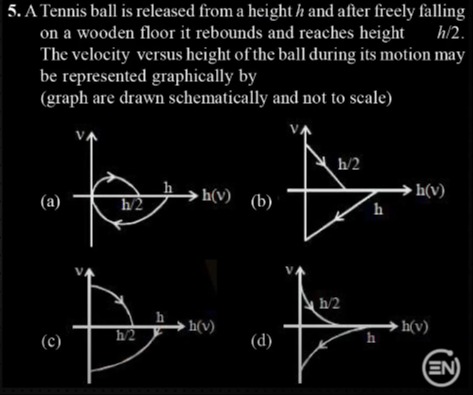Question
Question: A Tennis ball is released from a height *h* and after freely falling on a wooden floor it rebounds a...
A Tennis ball is released from a height h and after freely falling on a wooden floor it rebounds and reaches height h/2. The velocity versus height of the ball during its motion may be represented graphically by (graph are drawn schematically and not to scale)

A closed loop starts at h, goes down to h/2, then up to the origin, and back to h. Arrows indicate the direction of the loop.
Two straight lines form a triangle. One line goes from the origin to h/2 on the v-axis. The other line goes from the origin to h on the h-axis. Arrows indicate the direction of the lines.
A curve starts at h, goes down to h/2, then up to the origin. An arrow indicates the direction of the curve.
A curve starts at the origin, goes up to h/2, then down to h. An arrow indicates the direction of the curve.
Option (a)
Solution
A tennis ball is dropped from height h so that during free fall the speed at any height y (with y=h initially and y=0 at the floor) is given by
v=−2g(h−y).At the floor (y=0) its speed becomes
v=−2gh.After the bounce (assumed instantaneous) the ball rebounds with speed
2g(2h)=gh,and on rising its speed at any height y obeys
v=gh−2gy,reaching zero at y=2h.
When we plot velocity v (vertical axis) versus height y (horizontal axis), note that:
- At y=h the ball is at rest (point (h,0)).
- On its downward journey from y=h to y=0, the velocity is uniquely determined by v=−2g(h−y).
- At the floor (y=0) there are two distinct values: v=−2gh (just before impact) and v=gh (just after rebound).
- Finally, during the upward journey from y=0 to y=2h, the velocity is v=gh−2gy.
Thus, the complete motion in the v-y plane traces a closed loop (taking into account the sudden change at the floor) with two distinct branches corresponding to the downward and upward motions.
